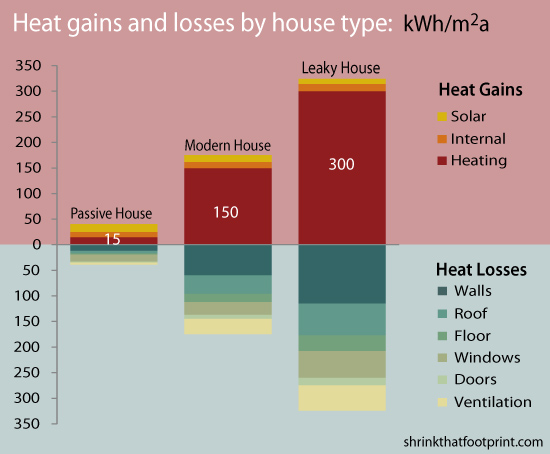What get you excited about your home? Is it your beautiful new contemporary kitchen? Maybe you have recently had a modern extension that has created a fantastic new family living area? It could be your luxurious bathroom where you can escape the stresses of daily life and unwind in peace? One thing I can guarantee you are not excited about is your insulation. Yes? No. I didn`t think so.
What if I described a family home with virtually no heating bill? Would that start to sound exciting? Maybe? What if I said that you could build your new home and achieve this without spending more than you would on your new kitchen? Well. I`m excited!
Have you heard of a Passivhaus? They’re quite wonderful. A Passive House (Passivhaus) is a super insulated energy efficient home. The reason why you should want one is they have tiny heating bills, minimal carbon footprints, are flooded with natural light and enjoy superior levels of comfort to normal homes.
Maximising your gains and minimising the losses
The simplest way to really get the genius of a Passivhaus is in terms of heat gains and losses. Because a house remains roughly the same temperature over the course of a year heat gains are equal to heat losses.
In a all houses heat gains come from a heating system, the sun’s warmth and internal gains from things like appliances and people. Heat losses occur through the walls, floor, roof, windows and doors or via ventilation in the form of air leakage.
If you take a look at the graphic at the top of this post, you’ll see three types of houses represented by their heat gains and losses as they might be in Northern Ireland. In each case the heat losses match the gains. Look at the losses in each house and you can understand what makes the Passivhaus special.
The leaky house is your typical house that 80% of Northern Irish people live in. It is at least 25 years old (still quite modern in some people`s eyes) has solid walls, poor loft insulation, an uninsulated floor, single glazed windows and lots of draughts. Because of this it needs 300 kilowatt-hours of heating for each square meter of space per year (kWh/m2a) just to stay warm. This equates to approximately a £2150.00 gas heating bill or £3125.00 oil heating bill, for the average size house – 1,600 sq ft.
The modern house would represent most of the new houses being built in Northern Ireland today. Modern building regulations have pushed the building industry to develop their product. It has insulation in the wall cavity and loft, an insulated floor, double glazing and some draught excluders. Because of its better insulation it needs just half the heating of the leaky house, 150 kWh/m2a, to maintain a similar internal temperature. This still equates to approximately a £1075.00 gas heating bill or £1562.50 oil heating bill!
The Passivhaus has superb insulation in all materials, triple glazed windows that face the equator to maximize solar gains, and is so air tight it uses a ventilation system to keep the air fresh. It needs just 15 kWh/m2a of heating, some of which comes from heat recovery in the ventilation system. The cost to heat the Passivhaus to the same temperature as the other two homes would be approximately a £101.25 gas heating bill or £148.00 oil heating bill.
Because of these qualities a Passivhaus has a tiny heating bill. That means a tiny carbon footprint too. There are now more than 30,000 of them around the world. They come in all shapes and sizes. They can be new build or retrofit, and have merit in both cold and hot climates.
Not just insulated but comfortable too
A Passivhaus is a funny mix of rocket science and common sense. The technology used in a Passivhaus costs more than in a typical home. To build a new one, or meet the retrofit standard, requires great materials, careful design and contractors that understand things like air-tightness and thermal bridging.
It is easy to look at the additional costs of a Passivhaus and question the payback, particularly for a retrofit. But there is much more to a Passivhaus than the trade off between upfront costs and heating bill savings. The average additional cost for a Passivhaus over and above a similar sized modern home would be approximately 7 to 10%.
The real savings are not just to year on year savings on your annual heating bill. You must consider the cumulative cost as energy prices increase by an average of 10 to 20%. A simple way to look at it is if you took the money you save each year and paid it into your mortgage account. This could reduce your term of your mortgage by up to 10 years and save you tens, or even hundreds of thousands of pounds.
We are currently finalising research for one of Northern Ireland`s major house developers to conclude the amount their customers could save with one of their proposed low energy homes. The figures are real and substantial. I look forward to posting the results when complete. Until then, please don`t hesitate to contact C60 Design, if you have any questions on how you can start to save money in your home.


